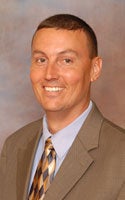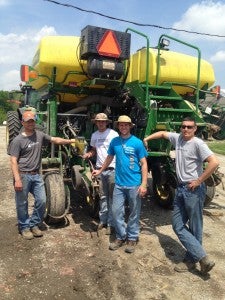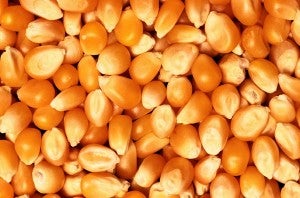Meet Brent Bible, state trooper turned farmer and mentor
 A new Purdue University study released this week found that agriculture will create nearly 60,000 jobs each year for the next five years. But to meet this growing demand, more students will need to graduate with agricultural degrees. And as the deputy secretary of the U.S. Department of Agriculture said in a recent interview, the farming sector must do more to work with students and the educational system as a whole.
A new Purdue University study released this week found that agriculture will create nearly 60,000 jobs each year for the next five years. But to meet this growing demand, more students will need to graduate with agricultural degrees. And as the deputy secretary of the U.S. Department of Agriculture said in a recent interview, the farming sector must do more to work with students and the educational system as a whole.
That’s where growers like Brent Bible come into play. Brent is inspiring the next generation of farmers, scientists, researchers, and agronomists through his work with Purdue students who help him operate his 3,000-acre grain farm in Indiana. He’s also promoting soil health, nutrient efficiency, and sustainable agriculture through changes in on-farm practices.
I asked Brent, a former Indiana state police officer, about his transition to the agricultural world, his work with the Soil Health Partnership, and what gets him out of bed every morning.
How did you get involved in farming after a career in law enforcement?
I grew up on a farm, but back then it was too small to be a livelihood for my family. Agriculture wasn’t even in the picture when I went to school at Purdue and then went onto a career in law enforcement. But given my roots, I always had one foot in the water on farming.
I later teamed up with a friend, now my fellow co-owner, and we were able to run a small farm operation that allowed us to have a little bit of extra income. We like to think that by being responsible land stewards, we later got noticed by larger property owners that leased us additional land. So over time we were able to expand the size of our farm from 600 to nearly 3,000 acres.

How do you work with Purdue students?
We’re fortunate to live close to Purdue, which has a huge agricultural program. Students from the university help us plant, harvest, and monitor crops – and in turn they’re learning about the world of farming.
At the end of the day, farming is a job and a livelihood, but I wouldn’t do this if I didn’t have a passion for it. There are many hard days that accompany this field, but I’m constantly challenging the students to do something that they would do for free. In other words, if you find passion in your career, you will be successful in life. That makes me excited to get to work each morning.
Can other growers take advantage of university resources?
I was a member of Purdue’s Farmhouse Fraternity which is still a great resource for me today. Many growers don’t have this connection, but anyone within reach of a land grant university or other agriculture-related university can reach out and make a connection. You never know what resources exist until you ask– and students are an incredibly engaged and passionate workforce.
How do your state trooper skills translate to the farm?
You would think that farming means you’re on a tractor by yourself and that you’re alone a lot of the time – but I’ve learned that isn’t the case. People skills and relationships were key in law enforcement, and it’s the same in agriculture.
I used to think that production agriculture was machine-oriented system, but it’s really a people-driven environment. People become your greatest resource. You can’t get equipment fixed without the right people, and I’m constantly asking agronomists and crop advisors for advice on products and technologies.

I hear my movie popcorn may come from your farm?
Maybe a few kernels! Of our 3,000 acres, two-thirds is corn and one-third is soybeans. Our operation is somewhat unique because we mostly grow seed corn and beans for Beck’s Hybrids. We grow a little bit of wheat as a rotational crop, and the rest of the fields are comprised of food-grade waxy corn, and a field or two of popcorn– which yes, is sold to ConAgra to make Orville Redenbacher popcorn.
How have you changed nutrient management practices in your operation?
We used to apply a standard amount of nutrients per acre. But we have evolved over time – we now take soil samples every two acres and use variable rate technology to get data about inputs. We aggregate the data on a field by field basis and can now fine tune our nutrient application so that the majority of the time, we’re saving money and increasing yields. We’re no longer just applying a blind amount of fertilizer – we’re being much more precise and applying only what is needed.
What other soil health practices have you embraced?
About half or two-thirds of our acres are no-till or minimum till depending on crop type and conditions each year. We made this change in part because of great advice from others who tried these practices but also because no-till just makes sense for some layouts and topographies. Through my work with the Soil Health Partnership (SHP), I’ve also been able to learn from others who have used cover crops and realized the benefits.
We are economically driven to do what will give you the best yield – no-till and cover crops are part of that equation. This year we had 350 acres of cover crops – we would not have been that aggressive if it wasn’t for our work with the SHP, which helped us develop confidence to try new methods.












